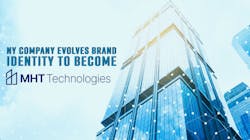Late last week, LEDs Magazine learned that New York-based MHT Lighting would change its name to reflect the company’s evolving business model as a smart building automation controls provider. The 14-year-old lighting manufacturer has rebranded its organization as “MHT Technologies” in a move designed to dispel “market confusion about the identity of the company” and “demonstrate that “[MHT] has been doing more than just lighting for a while,” chief marketing officer Kim Johnson told LEDs on Friday.
Established in 2009, MHT Lighting was an early mover in engineering lighting for the “digital ceiling” space, connected via PoE cabling to enable low-voltage power and later on data connectivity to fixtures as endpoints, as well as other building equipment. Its Staten Island facility will continue to operate and produce commercial-centric fixtures under the MHT Lighting brand name, while the umbrella of MHT Technologies will focus on advances in building performance at its Innovation Lab in New York City.
The name game
As a marketing executive who joined the company just shy of a year ago, Johnson said that “[our brand identity] has been a difficult balance to strike, because you have this legacy of MHT Lighting; that was a company that did fixtures early on in the low-voltage world, supporting some of the first low-voltage and [Power over Ethernet]-based companies from a smart lighting control factor.”
She continued, “Around 2015–2016, the company started to develop its own software, but it was operating under that legacy of the lighting manufacturing brand… That market identity as a lighting manufacturer was holding us back from our future, which is the smart building technology space.”
Chief revenue officer Ira Horowitz concurred, saying that the rebrand is about evolving company messaging and strategy with “clarity and consciousness” in mind. “The clarity [is centered] on who we view ourselves to be right now, which is more of a technology company than a fixture manufacturer or a lighting company.” He explained that MHT Technologies provides integration and control for compatible shading, sensors, and building management systems. “The ‘technology’ [aspect of MHT] needs to be at the forefront and that’s what we want to make people conscious of,” Horowitz said.
While Johnson said MHT Technologies will operate with a “new flexibility in terms of any product expansions” under the name change, the company will continue to produce low-voltage and PoE-based fixtures for commercial customers who need reliable, cost-effective luminaires for projects at scale.
Horowitz elaborated. “We’re sensitive to staying in our ‘swim lanes.’ There are things that MHT Lighting does very well…fixtures for data centers, for back of house.” The traditional lineup of purpose-built fixtures will continue to align with customer demands, he said.
Furthermore, Johnson observed, standardization across smart building technologies is imperative to smoothing the way for adoption. One of the company’s reasons for continuing to push ahead with PoE is the ability to integrate a number of device technologies into the building network on a standardized backbone, helped along by industry initiatives like the PoE Consortium that is working toward reducing installation and operational complexity with PoE devices and building systems for building engineers and integrators.
Accountability in automation
Still, Horowitz and Johnson want to differentiate MHT Technologies from other companies in the smart buildings space, placing priority on the flagship Inspextor automation platform that marked the company’s foray into software development and is the subject of three patents for MHT.
The Inspextor software integrates various data endpoints and building systems into a streamlined user interface or dashboard, with additional hardware, connectors, and switches for a fully interoperable networked facility. The software enables functions such as people tracking, indoor wayfinding, customizable climate control and lighting scenes, and energy usage monitoring, then users set goals for the facility and system policies to meet those goals — while maintaining human oversight.
In MHT’s media announcement, co-founder Akram Khalis noted that MHT Technologies “[views] automation as a means to enhance, not supplant, human abilities.” That means Inspextor users will receive recommended actions based on the data collected through the building operation and from occupant activities, but those prescribed actions still need to be approved by a system end user for accountability — what the company refers to as a “human-in-the-loop” (HITL) algorithm.
Horowitz said the key point he wants MHT to address with potential customers is not to lead with the PoE approach but to learn what their automation and networking needs are — “what [do] they want to accomplish with the space that they’re building?” he asked — and concluded that the true value of the smart system can only be realized with technologies that communicate properly with one another and with the building owner in a productive way.
Alongside the name change, MHT Technologies has redesigned its website with additional information about its products, integration partners, case studies, and New York-based Innovation Lab.
CARRIE MEADOWS is managing editor of LEDs Magazine, with 20-plus years’ experience in business-to-business publishing across technology markets including solid-state technology manufacturing, fiberoptic communications, machine vision, lasers and photonics, and LEDs and lighting.
Follow our LinkedIn page for our latest news updates, contributed articles, and commentary, and our Facebook page for events announcements and more. You can also find us on Twitter.








